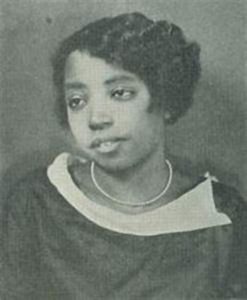
Marita Bonner
On this date, in 1898, Marita Bonner was born. She was a Black writer
One of four children, Bonner was born in Boston to Joseph Andrew and Mary Anne (Noel) Bonner. She was raised and educated in Boston, attended Brookline School, received musical training, and began mastering German. In 1918, she entered Radcliffe College, where she was deeply engaged in English and comparative literature.
Attending a time when Black students were routinely denied dormitory accommodations, Bonner commuted to campus. Nevertheless, she succeeded, winning the Radcliffe song competitions in 1918 and 1922. She also continued to study musical composition and German literature. While still a student, Bonner taught at a high school in Cambridge.
After graduating from Radcliffe in 1922, she moved to Washington, D.C., where she continued teaching. Bonner also became closely associated with poet, playwright, and composer Georgia Douglas Johnson, whose "S" Street salon was an important gathering place for many writers and artists associated with the New Negro Renaissance of the 1920s. She also began to publish her writing in journals like “The Crisis,” the publication of the National Association for the Advancement of Colored People (NAACP), and “Opportunity,” the official journal of the Urban League. Her first published pieces, “Hands” and “On Being Young, a Woman-and Colored,” appeared in 1925. Bonner's early essays, sketches, stories, and plays are notable for their brief, sometimes fragmentary character, lyricism, and experimental quality.
Her early works show her fascination with characters of mixed racial origins. Bonner also wrote three experimental plays during the 1920s, all of which were symbolic explorations of Black people's quest for freedom and dignity after Emancipation. In 1926, she published “Nothing New,” her first story explicitly set in Chicago and the introduction of what would become her fictional universe, Frye Street. In 1930, Bonner married William Almy Occomy. The couple moved to Chicago, where she lived for the next 41 years and raised her three children.
She resumed writing in 1933, published under her married name, and began to explore the urban fictional terrain that would appear after her death under the titles “Frye Street” and “Environs.” Bonner's “Frye Street” is a multi-ethnic urban universe, populated by streams of people drawn by the promises of urban life: Irish, Italian, Jewish, Chinese, French, Russian, and southern Black migrants. Yet “Frye Street” is a fallen world, marked by sharp racial divisions and social strife--a place where working people, particularly Black migrants to the city, struggle against the impersonal and destructive forces of urban life.
She wanted to chart this world at several levels, but her mapping of this fictional universe was never fully realized during her lifetime. After 1941, Bonner rarely published her work but devoted herself to teaching and raising her family. Marita Bonner, the author of "Frye Street," a work closely associated with the Harlem Renaissance, died of injuries from a fire in her Chicago apartment in 1971.
Black Women in America: An Historical Encyclopedia
Volumes 1 and 2, edited by Darlene Clark Hine
Copyright 1993, Carlson Publishing Inc., Brooklyn, New York
ISBN 0-926019-61-9